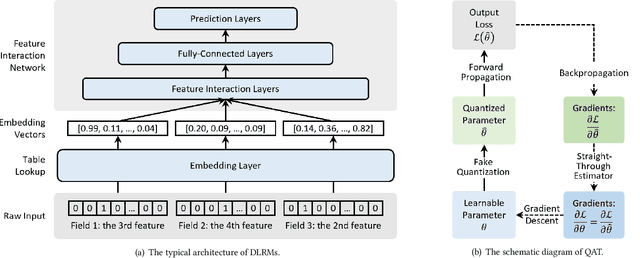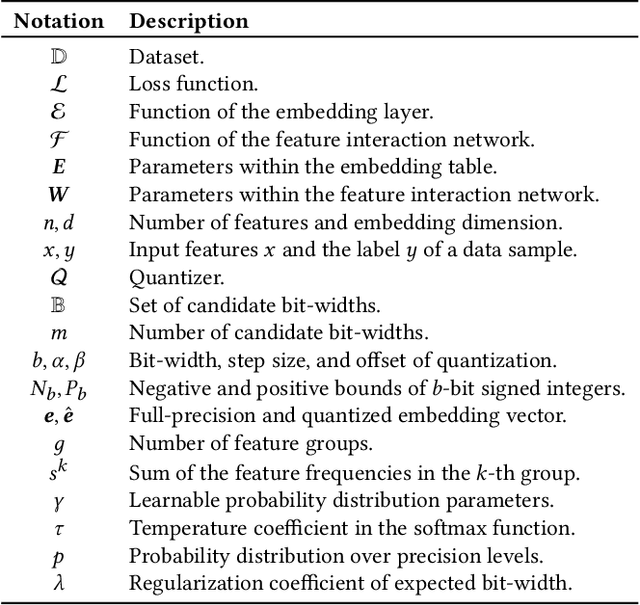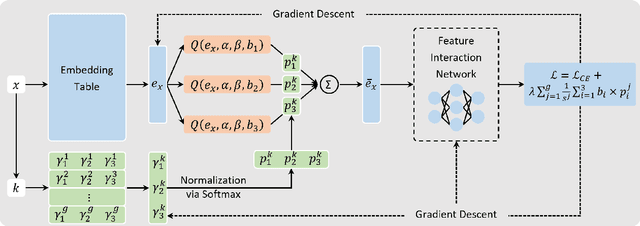Shiwei Li
BoRA: Towards More Expressive Low-Rank Adaptation with Block Diversity
Aug 09, 2025Abstract:Low-rank adaptation (LoRA) is a parameter-efficient fine-tuning (PEFT) method widely used in large language models (LLMs). It approximates the update of a pretrained weight matrix $W\in\mathbb{R}^{m\times n}$ by the product of two low-rank matrices, $BA$, where $A \in\mathbb{R}^{r\times n}$ and $B\in\mathbb{R}^{m\times r} (r\ll\min\{m,n\})$. Increasing the dimension $r$ can raise the rank of LoRA weights (i.e., $BA$), which typically improves fine-tuning performance but also significantly increases the number of trainable parameters. In this paper, we propose Block Diversified Low-Rank Adaptation (BoRA), which improves the rank of LoRA weights with a small number of additional parameters. Specifically, BoRA treats the product $BA$ as a block matrix multiplication, where $A$ and $B$ are partitioned into $b$ blocks along the columns and rows, respectively (i.e., $A=[A_1,\dots,A_b]$ and $B=[B_1,\dots,B_b]^\top$). Consequently, the product $BA$ becomes the concatenation of the block products $B_iA_j$ for $i,j\in[b]$. To enhance the diversity of different block products, BoRA introduces a unique diagonal matrix $\Sigma_{i,j} \in \mathbb{R}^{r\times r}$ for each block multiplication, resulting in $B_i \Sigma_{i,j} A_j$. By leveraging these block-wise diagonal matrices, BoRA increases the rank of LoRA weights by a factor of $b$ while only requiring $b^2r$ additional parameters. Extensive experiments across multiple datasets and models demonstrate the superiority of BoRA, and ablation studies further validate its scalability.
The Panaceas for Improving Low-Rank Decomposition in Communication-Efficient Federated Learning
May 29, 2025Abstract:To improve the training efficiency of federated learning (FL), previous research has employed low-rank decomposition techniques to reduce communication overhead. In this paper, we seek to enhance the performance of these low-rank decomposition methods. Specifically, we focus on three key issues related to decomposition in FL: what to decompose, how to decompose, and how to aggregate. Subsequently, we introduce three novel techniques: Model Update Decomposition (MUD), Block-wise Kronecker Decomposition (BKD), and Aggregation-Aware Decomposition (AAD), each targeting a specific issue. These techniques are complementary and can be applied simultaneously to achieve optimal performance. Additionally, we provide a rigorous theoretical analysis to ensure the convergence of the proposed MUD. Extensive experimental results show that our approach achieves faster convergence and superior accuracy compared to relevant baseline methods. The code is available at https://github.com/Leopold1423/fedmud-icml25.
Beyond Zero Initialization: Investigating the Impact of Non-Zero Initialization on LoRA Fine-Tuning Dynamics
May 29, 2025Abstract:Low-rank adaptation (LoRA) is a widely used parameter-efficient fine-tuning method. In standard LoRA layers, one of the matrices, $A$ or $B$, is initialized to zero, ensuring that fine-tuning starts from the pretrained model. However, there is no theoretical support for this practice. In this paper, we investigate the impact of non-zero initialization on LoRA's fine-tuning dynamics from an infinite-width perspective. Our analysis reveals that, compared to zero initialization, simultaneously initializing $A$ and $B$ to non-zero values improves LoRA's robustness to suboptimal learning rates, particularly smaller ones. Further analysis indicates that although the non-zero initialization of $AB$ introduces random noise into the pretrained weight, it generally does not affect fine-tuning performance. In other words, fine-tuning does not need to strictly start from the pretrained model. The validity of our findings is confirmed through extensive experiments across various models and datasets. The code is available at https://github.com/Leopold1423/non_zero_lora-icml25.
Semantic Retrieval Augmented Contrastive Learning for Sequential Recommendation
Mar 06, 2025Abstract:Sequential recommendation aims to model user preferences based on historical behavior sequences, which is crucial for various online platforms. Data sparsity remains a significant challenge in this area as most users have limited interactions and many items receive little attention. To mitigate this issue, contrastive learning has been widely adopted. By constructing positive sample pairs from the data itself and maximizing their agreement in the embedding space,it can leverage available data more effectively. Constructing reasonable positive sample pairs is crucial for the success of contrastive learning. However, current approaches struggle to generate reliable positive pairs as they either rely on representations learned from inherently sparse collaborative signals or use random perturbations which introduce significant uncertainty. To address these limitations, we propose a novel approach named Semantic Retrieval Augmented Contrastive Learning (SRA-CL), which leverages semantic information to improve the reliability of contrastive samples. SRA-CL comprises two main components: (1) Cross-Sequence Contrastive Learning via User Semantic Retrieval, which utilizes large language models (LLMs) to understand diverse user preferences and retrieve semantically similar users to form reliable positive samples through a learnable sample synthesis method; and (2) Intra-Sequence Contrastive Learning via Item Semantic Retrieval, which employs LLMs to comprehend items and retrieve similar items to perform semantic-based item substitution, thereby creating semantically consistent augmented views for contrastive learning. SRA-CL is plug-and-play and can be integrated into standard sequential recommendation models. Extensive experiments on four public datasets demonstrate the effectiveness and generalizability of the proposed approach.
Matrix3D: Large Photogrammetry Model All-in-One
Feb 11, 2025Abstract:We present Matrix3D, a unified model that performs several photogrammetry subtasks, including pose estimation, depth prediction, and novel view synthesis using just the same model. Matrix3D utilizes a multi-modal diffusion transformer (DiT) to integrate transformations across several modalities, such as images, camera parameters, and depth maps. The key to Matrix3D's large-scale multi-modal training lies in the incorporation of a mask learning strategy. This enables full-modality model training even with partially complete data, such as bi-modality data of image-pose and image-depth pairs, thus significantly increases the pool of available training data. Matrix3D demonstrates state-of-the-art performance in pose estimation and novel view synthesis tasks. Additionally, it offers fine-grained control through multi-round interactions, making it an innovative tool for 3D content creation. Project page: https://nju-3dv.github.io/projects/matrix3d.
ONER: Online Experience Replay for Incremental Anomaly Detection
Dec 05, 2024Abstract:Incremental anomaly detection sequentially recognizes abnormal regions in novel categories for dynamic industrial scenarios. This remains highly challenging due to knowledge overwriting and feature conflicts, leading to catastrophic forgetting. In this work, we propose ONER, an end-to-end ONline Experience Replay method, which efficiently mitigates catastrophic forgetting while adapting to new tasks with minimal cost. Specifically, our framework utilizes two types of experiences from past tasks: decomposed prompts and semantic prototypes, addressing both model parameter updates and feature optimization. The decomposed prompts consist of learnable components that assemble to produce attention-conditioned prompts. These prompts reuse previously learned knowledge, enabling model to learn novel tasks effectively. The semantic prototypes operate at both pixel and image levels, performing regularization in the latent feature space to prevent forgetting across various tasks. Extensive experiments demonstrate that our method achieves state-of-the-art performance in incremental anomaly detection with significantly reduced forgetting, as well as efficiently adapting to new categories with minimal costs. These results confirm the efficiency and stability of ONER, making it a powerful solution for real-world applications.
A Survey on Data Synthesis and Augmentation for Large Language Models
Oct 16, 2024Abstract:The success of Large Language Models (LLMs) is inherently linked to the availability of vast, diverse, and high-quality data for training and evaluation. However, the growth rate of high-quality data is significantly outpaced by the expansion of training datasets, leading to a looming data exhaustion crisis. This underscores the urgent need to enhance data efficiency and explore new data sources. In this context, synthetic data has emerged as a promising solution. Currently, data generation primarily consists of two major approaches: data augmentation and synthesis. This paper comprehensively reviews and summarizes data generation techniques throughout the lifecycle of LLMs, including data preparation, pre-training, fine-tuning, instruction-tuning, preference alignment, and applications. Furthermore, We discuss the current constraints faced by these methods and investigate potential pathways for future development and research. Our aspiration is to equip researchers with a clear understanding of these methodologies, enabling them to swiftly identify appropriate data generation strategies in the construction of LLMs, while providing valuable insights for future exploration.
Mixed-Precision Embeddings for Large-Scale Recommendation Models
Sep 30, 2024



Abstract:Embedding techniques have become essential components of large databases in the deep learning era. By encoding discrete entities, such as words, items, or graph nodes, into continuous vector spaces, embeddings facilitate more efficient storage, retrieval, and processing in large databases. Especially in the domain of recommender systems, millions of categorical features are encoded as unique embedding vectors, which facilitates the modeling of similarities and interactions among features. However, numerous embedding vectors can result in significant storage overhead. In this paper, we aim to compress the embedding table through quantization techniques. Given that features vary in importance levels, we seek to identify an appropriate precision for each feature to balance model accuracy and memory usage. To this end, we propose a novel embedding compression method, termed Mixed-Precision Embeddings (MPE). Specifically, to reduce the size of the search space, we first group features by frequency and then search precision for each feature group. MPE further learns the probability distribution over precision levels for each feature group, which can be used to identify the most suitable precision with a specially designed sampling strategy. Extensive experiments on three public datasets demonstrate that MPE significantly outperforms existing embedding compression methods. Remarkably, MPE achieves about 200x compression on the Criteo dataset without comprising the prediction accuracy.
Masked Random Noise for Communication Efficient Federaetd Learning
Aug 06, 2024Abstract:Federated learning is a promising distributed training paradigm that effectively safeguards data privacy. However, it may involve significant communication costs, which hinders training efficiency. In this paper, we aim to enhance communication efficiency from a new perspective. Specifically, we request the distributed clients to find optimal model updates relative to global model parameters within predefined random noise. For this purpose, we propose Federated Masked Random Noise (FedMRN), a novel framework that enables clients to learn a 1-bit mask for each model parameter and apply masked random noise (i.e., the Hadamard product of random noise and masks) to represent model updates. To make FedMRN feasible, we propose an advanced mask training strategy, called progressive stochastic masking (PSM). After local training, each client only need to transmit local masks and a random seed to the server. Additionally, we provide theoretical guarantees for the convergence of FedMRN under both strongly convex and non-convex assumptions. Extensive experiments are conducted on four popular datasets. The results show that FedMRN exhibits superior convergence speed and test accuracy compared to relevant baselines, while attaining a similar level of accuracy as FedAvg.
FedBAT: Communication-Efficient Federated Learning via Learnable Binarization
Aug 06, 2024



Abstract:Federated learning is a promising distributed machine learning paradigm that can effectively exploit large-scale data without exposing users' privacy. However, it may incur significant communication overhead, thereby potentially impairing the training efficiency. To address this challenge, numerous studies suggest binarizing the model updates. Nonetheless, traditional methods usually binarize model updates in a post-training manner, resulting in significant approximation errors and consequent degradation in model accuracy. To this end, we propose Federated Binarization-Aware Training (FedBAT), a novel framework that directly learns binary model updates during the local training process, thus inherently reducing the approximation errors. FedBAT incorporates an innovative binarization operator, along with meticulously designed derivatives to facilitate efficient learning. In addition, we establish theoretical guarantees regarding the convergence of FedBAT. Extensive experiments are conducted on four popular datasets. The results show that FedBAT significantly accelerates the convergence and exceeds the accuracy of baselines by up to 9\%, even surpassing that of FedAvg in some cases.
 Add to Chrome
Add to Chrome Add to Firefox
Add to Firefox Add to Edge
Add to Edge